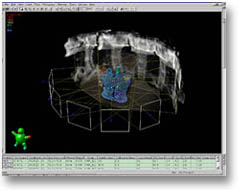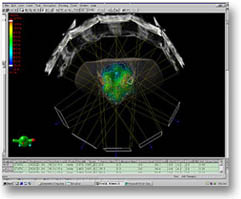
IMRT is a state-of-the-art cancer treatment method that delivers high doses of radiation directly to cancer cells in a very targeted way, much more precisely than is possible with conventional radiotherapy. IMRT can deliver higher radiation doses directly to cancer cells while sparing more of the surrounding healthy tissue.This has important advantages in oral cancers as it allow the beams to hit their target area while missing the surrounding structures such as the salivary glands.
IMRT uses computer-generated images to plan, and then deliver tightly focused radiation beams to cancerous tumors. Clinicians use it to exquisitely "paint" the tumor with a precise radiation beam that conforms as closely as possible to the shape of the tumor.
IMRT can be used to treat tumors that might have been considered untreatable in the past due to close proximity of vital organs and structures. Treating such tumors requires tremendous accuracy. For example, in the case of head and neck tumors, IMRT allows radiation to be delivered in a way that minimizes exposure of the spinal cord, optic nerve, salivary glands or other important structures. In the case of prostate cancer, exposure of the nearby bladder or rectum can be minimized. IMRT is being used to treat tumors in the brain, breast, head and neck, liver, lung, nasopharynx, pancreas, prostate, and uterus.

A powerful computer program optimizes a treatment plan based on a physician’s dose instructions, and information about tumor size, shape and location in the body. A medical linear accelerator, equipped with a special device called a multileaf collimator that shapes the radiation beam, delivers the radiation in accordance with the treatment plan.
The equipment can be rotated around the patient to send radiation beams from the most favorable angles for giving the tumor a high dose while preserving important healthy tissues. Look at these images of multiple angle beams, and compare them in your mind to the conventional 3-beam approach (left, right, and front). Obviously when the tumor is very localized, this method of treatment has distinct advantages.




